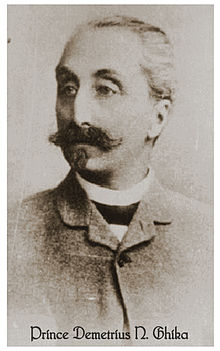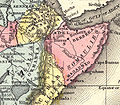- Dimitrie Ghica-Comăneşti
-
Dimitrie Ghika-Comăneşti (also Demeter Ghika, Ghika Comăneşteanu, Prince Ghika de Roumanie; December 31, 1839–1923) was a Romanian nobleman, explorer, famous hunter, adventurer and politician. He was born into the Ghica family, with nobiliary ancestry roots beginning in the 17th century. He was the son of Ecaterina Plagino (1820-1881) and aga (Rom. archaic - Chief of Justice) Nicolae (Nicholas) Ghika, boyar (b. Iaşi 1798- d. Comăneşti 1853) whom he inherited the estate domains of Comăneşti and Palanca from, two of the ten his father had. He graduated as Juris Doctor from the University of Berlin, and pursued his career as prefect of Bacău County, magistrate, and member of the Chamber of Deputies of Romania between 1872 and 1892 and further as royal adviser.
Like his father, since childhood he was an avid outdoor enthusiast, and educated himself about nature, only to become later a prominent member of the Romanian Geographical Society, one of the very firsts in the world, founded in 1875. He remarked himself in studies of zoology, botany and geology, geography and topography. He married Zoe Lahovary (1851-1902); they had one son, Nicolae (Nicholas) Ghika (1875-1921), who followed in his father's path. He was chairman and president of the Senate. Also they had a daughter, Maria (1870-1952), married Prince Leon Mavrocordato (1858-1939), military attaché in Viena.
Like many other Eastern European explorers, the Ghikas were of noble blood, high education and considerable family wealth, major factors that fueled their bold ventures. After the opening of Suez Canal in late 1869, a new era in African exploration has begun, specially after British took control of the canal in 1882, when sea trips to Africa from Europe via Mediterranean Sea became very common. However, few people ventured past the relative comforts of the cities and trade zones, and the ones that did, for the most part, perished killed by hostile natives, like lieutenant Stroyan, Pietro Sacconi in 1883, or the Greek merchant Panaghiotis, Italian Count Gianpetro Porro in 1883, others by wild beasts like Prince Eugene Ruspoli in 1891 who found its end trampled by an angry elephant. Ones that did were adventurous spirits with hunting or exploration in mind. The Ghikas, father and son, had both and between 1894 and 1895 ventured deeper than any European in the Horn of Africa, crossing today's Ethiopia, Djibouti and Somalia, where they made notable geographical explorations and natural history discoveries.
Their exploits on the African continent are typical for the upper class of the Victorian era, filled with safaris and extensive hunting of exotic species. The Ghikas sailed from Europe on the Imperatrix to Aden, then crossed into Africa at the port of Berbera, at the time the capital of British Somaliland , and on 22 October 1894 a massive caravan of over seventy luggage camels, four horses, two mules and three donkeys serving as lion bait, not counting hordes of sheep and goats for food, parted on a journey that will last almost a half year in the interior of the continent. The caravan crew consisted of 53 porters, few scouts from local tribes, four shikari hunting guides, two valets and the two Ghikas. They crossed the Gouban plains, traversed the Ogo plateau, to the Shebelle River and the north range of the Mountains of the Moon. After crossing the Somalian highlands they entered northern Ethiopia, where they started intensive hunting, collecting specimens. The Ghikas were seasoned big game hunters already from back home, Romania, where they pursued trophy brown bears in the Carpathian Mountains, stags and wild boars at the Dofteana estate where his family had a hunting chateau, or in the Danube Delta, enjoying fishing and hunting as a favorite pastime. The plants and animals collected during their African expedition were sent to private but mostly academic collections, notably the Romanian National Museum of Natural History (known today as Grigore Antipa Museum), located in Bucharest. An account of the hunting species, very grave by modern standards, quotes their exploits at: four lions (including the two man-eaters of Del-Marodile), five elephants, fifteen crocodiles, around a dozen rhinos, one giraffe (a new subpecie), two panthers, seven hyaenas, fifteen zebras, three wild asses (onagers), two greater kudu, eleven lesser kudus, eight hartebeest, twenty five oryx antelopes (gemsbok), eight warthogs, around one hundred different gazelles plus foxes, jackals, monkeys. Even though avid hunters, they did not neglect flora, and their discoveries are well-noted in their Plantarum enumeratio et descriptio work with names like Loranthua ghikae , Ghikea spectabilis or Ipomoea ghika and other names titillating Romanian royalty were given to the new sixteen species of plants discovered by them; they even discovered a new botanical genus which the German savants named Ghikae in their honor. Members of the Romanian Geographic Society, they made keen and pertinent descriptions of the flora, fauna, geology and the people they encountered and compiled maps. The analogy of their adventures to the later ones of United States President Theodore Roosevelt and his son, Kermit Roosevelt, in East Africa, to much extent is striking.
The first book about the Ghika's African voyage, published in German and French was Cinq mois aux pays des Somalis came out in 1898 in Geneva, and was written by G. A. Schweinfuhrt, G. Volkens and Nicolas D. Ghika (see photos below). Prior and after that notable academic institutions all throughout Europe published articles and recorded their deeds, including the British Royal Geographic Society. Another book was Un voyage en Afrique (A voyage in Africa - French and Romanian).
The Ghika's passion for hunting was remarkable, both father and son being noted as acquiring world record game trophies not only at home in Romania of European stag Cervus elaphus but also Africa's plains or dangerous game including: elephant, black rhino, oryx, kudu, waterbuck and gazelles, according to Rowland Ward (Records of Big Game, third edition, London).
Prior to his dramatic suicide in 1921, his son Nicholas continued passionately hunting and venturing the world, further in sultanate of Morocco and Saharan desert in 1899 and later, in 1910, to Canada and Alaska, all the way to Kodiak Island, probably drawn in pursuit by the world's largest land carnivore, the Kodiak grizzly.
Two years after his son, Nicolas, committed suicide, Demetrius Ghika died of broken heart in 1923 and was buried together with his family and son nearby his estate in Comăneşti, Romania, at the St. Spiridon church cemetery.
His estate's residence, the Ghika Chateau (or Palatul Ghica - Rom.) built in 1880, in late Baroque style, by the French architect Albert Galleron, (also designer of the Romanian National Bank and the Romanian Atheneum) stands still, wonderfully preserved until today, serving as Demeter Ghika Museum of Ethnography and Contemporary Art ("Dimitrie N. Ghika Comăneşti" - Rom.). The property is situated in Comanesti, small town in Bacau district. The museum is host to popular arts and crafts collection and a section of contemporary Romanian beaux-arts. Adjacent to the chateau, a nineteen acre dendrological park boasts rare, exotic and decorative species of trees from Asia and North America.
Timeline of the Ghika expedition in Somaliland
- 1895
22 October - Started crossing Ogaden coastal plains, moving into the arid deserts of Gouban
25 October - The high plateaus of ‘Ogo then the Haud country
27 October - Leferoug
29 October - Bouhalgachan, oryx hunts
30 October - Reached fortress of Hargeysa where he met Sheik Mattar trying to avoid Abyssinian troops of King Menelik expedition changes course further south through the country of Aniya Oromo tribes, tributaries of Menelik, less violent
2 November - Closer to the Abyssinian border, the Ghikas kill their first lions on a close encounter
4 November - Reaching Harar mountains, entering in the Ethiopian Alps
9 November - Prairies and forests of Harar
14 November - Reaching fortress of Jijiga
19 November - Mount Sabatwein, after crossing Jerer and Fafen Rivers, where the father was almost killed by a charging rhino during a hunt
24 November - Crossing Fafen river
25 November - Reached Degehamedo
30 November - Daghato river region hunting panthers and Nicolas has a close escape from an angry bull elephant in the highland forests.
6 December - Mountains of Kaldech, Khodjar and Djigo
21 December - Crossing Shebeli River (Leopards River)
27 December - Venturing into a never explored land of the Aulihan tribes
31 December - Entering the Oromo country and discoveries of the alabaster cave, and hunted first giraffe
- 1896
5 Jan. - At the confluence of Webu with Madesso, they adopt a child, the last survivor of a Geleimis Somali village completely massacred by Abyssinian warriors.
8 Jan. - Discovered another impressive alabaster cave and named her after the Princess Marie of Romania
9 Jan - Dek-Marodi and Ouasasale (Wasasali) mountains
13 Jan. - Enter the Del-Marodile and killed the two man-eating lions that ravaged the village
21 Jan. - Crossed the fertile plains of En and Sibi
23 Jan. - Entered the country of Melengour tribes of Somalis, villages of Sassabene
24 Jan. - Biosoro Mountains
25 Jan. - Entering the Haud plateau, helped the Sheik of the Habr Awal retrieve his stolen livestock by the Rer-Ali tribe
5 February - Rest at Hargeisa, then head north crossing Mt. Gah-Liba, Mt. Golis, Rock of The Seven Thieves and then entered Mandeira
20 February - Arrived at the port of Berbera
Timeline was based on the book Cinq mois aux pays des Somalis by Nicolas Ghika, G. A. Schweinfuhrt and G. Volkens, in Geneva, 1898
References
- (Romanian) Iorgu Petrescu, 110 ani de la expediţia lui Dimitrie şi Nicolae Ghika-Comăneşti în Somalia, Revista Muzeelor, 27 March 2005
Categories:- Romanian judges
- Members of the Chamber of Deputies of Romania
- Prefects of Romania
- Ghica family
- Explorers of Africa
- 1839 births
- 1923 deaths
Wikimedia Foundation. 2010.







